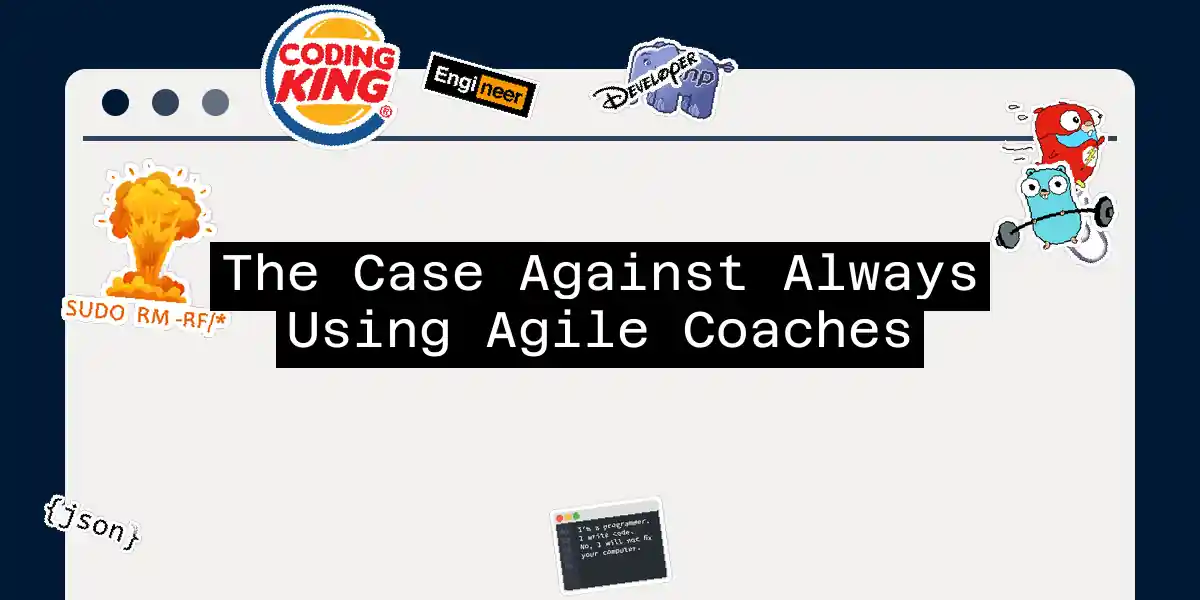The Agile Coach Conundrum
In the ever-evolving landscape of software development, Agile methodologies have become the de facto standard for many teams. However, the role of the Agile coach, meant to facilitate this transition, has come under scrutiny. While Agile coaches are intended to guide teams towards greater agility and efficiency, there are compelling arguments against their universal application. Let’s dive into the complexities and potential pitfalls of relying on Agile coaches.
The Disconnect Between Theory and Practice
One of the primary concerns is the disconnect between the theoretical ideals of Agile and the practical realities of software development. Agile coaches often come with a set of predefined practices and frameworks, which they insist teams must follow to be “Agile.” However, this one-size-fits-all approach can be detrimental. As noted in various critiques, Agile coaches may push for unnecessary formalities and meetings that do not ultimately aid in delivery.
For instance, consider the Plan-Do-Check-Act (PDCA) cycle, a cornerstone of Agile methodologies. While it is essential, overemphasizing it can lead to an excessive number of meetings, such as retrospectives, which may not provide significant value beyond what is already being done.
This cycle, while beneficial, should not be overused to the point of causing more meetings than necessary. The key is balance and relevance to the specific needs of the team.
The Issue of Local Optimization
Another critical point is the concept of local optimization versus whole-system optimization. Agile coaches often focus on optimizing specific parts of the organization, which can lead to sub-optimization of the whole system. This local optimization can be harmful, as it may not align with the broader goals of the organization.
In software development, optimizing a single team’s processes might not necessarily contribute to the overall efficiency of the project. For example, if a team is optimized for speed but neglects quality, it could lead to downstream problems that outweigh any short-term gains.
Misalignment with Business Objectives
There is a growing sentiment that Agile coaches are detached from the real business objectives. In many cases, Agile coaches prioritize the “Agile way” over actual business needs, leading to a disconnect between what the organization values and what the coach is pushing for.
This misalignment can result in coaches being seen as out of touch with reality. For instance, if an organization’s primary goal is to meet specific business objectives, an Agile coach who focuses solely on Agile principles without considering these objectives may be seen as irrelevant or even counterproductive.
Lack of Real-World Experience
A significant criticism of Agile coaches is their lack of real-world experience. Many coaches have never been in the trenches, facing the same challenges that the teams they are coaching encounter. This lack of practical experience can make their advice seem theoretical and unhelpful.
Imagine hiring a coach who has never written a line of code but is tasked with teaching developers how to work better. This scenario is not only unhelpful but also demotivating for the team.
The Need for Leadership Involvement
One of the most compelling arguments against the traditional role of Agile coaches is the need for leadership involvement. Many coaches focus on training teams rather than engaging with leadership, which can perpetuate a disconnect between the teams and management.
For true organizational change, it is crucial to involve leadership from the outset. Coaching leadership on Agile principles ensures that there is a unified understanding and alignment across the organization. This approach helps in avoiding the common pitfall where teams are “Agile” but management is not, leading to a dysfunctional organization.
The Risk of Quackery
The term “Agile coach” is not a protected title, which means anyone can claim to be an Agile coach. This lack of regulation leads to a risk of quackery, where unqualified individuals can do more harm than good.
For example, a coach who advises teams to “find things out by themselves” without providing any guidance can be more of a hindrance than a help. This approach not only frustrates team members but also undermines the credibility of genuine Agile coaches.
Conclusion
While Agile coaches can be beneficial in guiding teams towards more agile practices, it is crucial to approach their role with a critical eye. The potential for misalignment with business objectives, lack of real-world experience, and the risk of quackery are significant concerns that need to be addressed.
Instead of blindly relying on Agile coaches, organizations should focus on involving leadership in the coaching process and ensuring that any changes align with the broader goals of the organization. By doing so, we can avoid the pitfalls associated with Agile coaching and foster a more effective and sustainable approach to software development.
In the end, it’s not about being “Agile” for the sake of it; it’s about creating a system that truly supports the needs of both the team and the organization. As we navigate the complex world of software development, let’s remember that sometimes, the best way forward is not to follow the crowd but to forge our own path.
